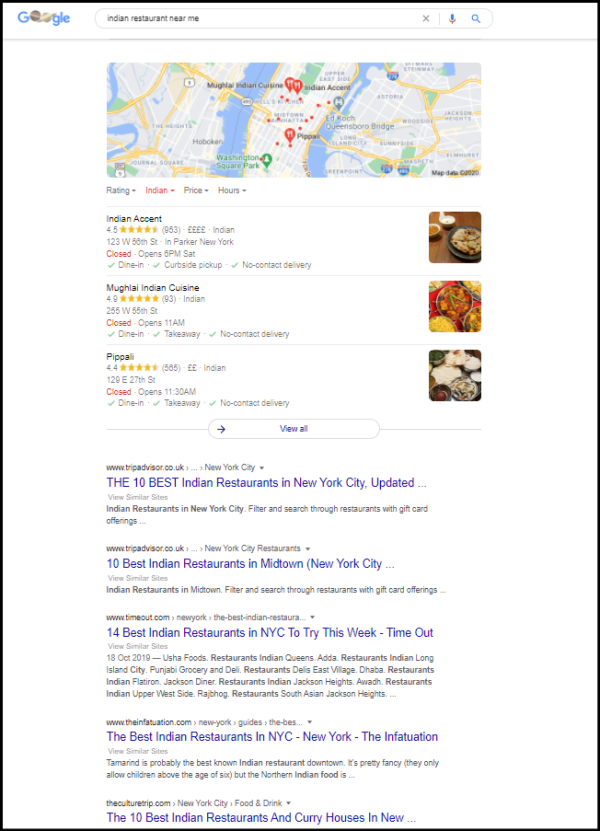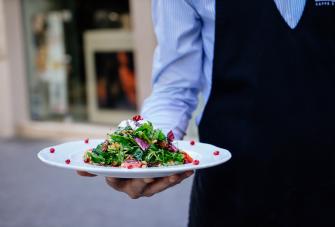How to Rank for “restaurant near me"
When people are looking for a new local restaurant at which to eat out, one of the most common ways that they find new places is simply to Google: “restaurant near me”.
This is demonstrated by the fact that the term “restaurant near me” is searched approximately 304,000 times a month. This does not even take into account related searches such as “Italian restaurant near me” and “Chinese restaurant near me”. Taken together all these “near me” keywords are searched approximately 727,000 times a month in the USA.
Given this search volume, ranking your restaurant (or any other local brick and mortar business) for it’s relevant “near me” search is one of the best ways to bring in a consistent stream of new customers.
Ranking for these searches requires a very specific strategy, that is separate from traditional approaches to SEO. Here is a breakdown of exactly what you should focus on for “near me” searches.
What does Google show when people search “restaurant near me”
In order to understand how to optimize for a search like “restaurant near me” we need to know what Google displays when a user makes a search.
Here is what Google shows when someone in New York City searches for “Indian restaurant near me” - note that Google delivers similar results no matter what type of restaurant we are searching for.
The results that Google shows here can be divided into three categories. Listed from top to bottom of the page, they are:
- A Google Map and map listings
- Web pages containing lists of relevant restaurants
- Websites of restaurants themselves
The interactive Google Map and its three listings get the lion’s share of clicks for this search, given that they are displayed first and are granted such a large amount of screen space.
This is particularly true when searching on a phone, as the map is the only thing you will see without scrolling down.
The following will therefore only talk about how to optimize for visibility in the map as this will bring the largest results for the least amount of work.
How does Google decide what to rank in its map for “near me searches”?
When deciding what to rank in the Google map, the search engine looks at four key variables:
- The proximity of the restaurant to a searcher’s location (determined by their IP address)
- The completeness of a restaurant’s Google My Business listing
- The consistency of citations of a restaurant’s name, address and phone number
- The click-through rate of a restaurant’s map listing.
Given that the first of these factors is beyond our control, we will go through how to optimize for the second, third and fourth variables.
Optimizing your restaurant’s Google My Business listing
The Google Map that sits atop the search results for “near me” searches is embedded with pins of local businesses relevant to whatever search was made. It also has a list of these businesses, either directly below the map itself, or to the left of it if you click on it:

Both the embedded pins and the listings are linked to the restaurant’s Google My Business profile.
The first consequence of this is that your restaurant needs a Google My Business listing to even compete on the map. If you have not claimed your listing then you can find out how to do so here.
The second consequence of Google showing Google My Business profiles on its map is that Google My Business profiles that are completely filled out will be given more visibility than ones that are not.
The reason for this is that Google wants to give its users the most accurate and useful information possible. Google My Business profiles with all its possible fields filled out are more likely to do this.
When you create this profile, you are given a huge number of fields to fill out. Try to complete as many of these fields as possible. This may involve sourcing images of your food, premises and staff, as well as creating a bio and linking to your menu and any takeout platforms you use.
Do not neglect this. Google will make it easy for users to click straight onto your menu and delivery platforms from the map.

Having consistent citations of your restaurant’s name, address and phone number
Although Google primarily understands your restaurant’s location from its address on your Google My Business profile, it looks for other instances of your restaurant’s name address, and phone number in verifying its location.
When the search engine sees these three elements lumped together on a relevant site, it understands that it refers to your restaurant. This means that you should look to create content that contains your restaurant’s name, address and phone number in places where it makes sense for a restaurant’s details to exist.
The most effective way to do this is to make profiles on local and industry-relevant directories. Yelp, Yell, and Foursquare are three such examples of this, but anywhere that lists local establishments will work.
As Google sees more of these citations it will increase the search engine’s confidence about who you are, what you do, and where you are based. This confidence will be reflected in the prominence that it gives your restaurants in relevant, location-based searches.
Be careful when making these citations. Google is not yet sophisticated enough to understand that different “versions” of an address refer to the same place. If you have your address listed as “Warwick Avenue” on one directory and “Warwick Ave” on another, Google will lose confidence in your location. With enough inconsistencies, your map coverage will suffer as the search engine does not want to deliver inaccurate results.
It’s worth reviewing your current directory listings to weed out inconsistencies before you add new ones. This is particularly important if you have moved premises during your existence.
Maximizing your listing’s click-through rate
Click-through rate refers to the number of times that your listing is clicked compared to the other listings that appear for a particular search.
If Google registers that one result is being clicked significantly more often than the others for a specific search, it will see this as a signal that the result in question is the best fit for this search. It will therefore give it more prominence in the future.
The most effective way in maximising your restaurant listings click-through rate is to collect a higher number of positive reviews than your competitors.
When Google shows a listing of restaurants either below or to the left of the map, it displays the number of reviews a restaurant has as well as its average rating.

Users are increasingly basing their buying decision on these reviews, so collecting a higher number of positive reviews than your competitors should see your listing be clicked more often on average.
Note that having positive reviews does not push you up the map listing in itself. Rather this effect is indirect and works through increasing your click-through rate.
Wrapping up
Although optimizing for “near me” search is simple on a technical level, the key to success is consistency.
Google is always adding new fields to Google My Business, so make sure you are on top of these. New places to add citations regularly pop up, so again make sure you are reviewing this regularly. You can never have enough positive reviews.
Over time this diligence will reap its rewards.

This article was written by Oli Graham. Oli is the Marketing Manager for digital content agency RightlyWritten.




